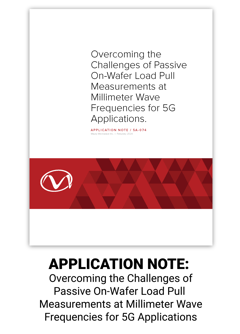Time division duplex (TDD) is a favorable scheme for 5G. Uplink and downlink transmissions occur on...
How Can Designers Optimize Power Amplifiers for 5G Millimeter Wave Systems?
5G systems operate over various frequencies, which are often separated into three distinct regions – low-band, mid-band, and high-band. In this blog post, discover the differences between high-frequency millimeter wave (mmWave) systems and lower frequency 5G bands, as well as advanced test techniques for optimizing amplifier performance in demanding mmWave environments.
5G Frequency Band Breakdown
Low-band
Typically operating in the sub-1 GHz range, low-band 5G provides the broadest coverage, utilizing signals that can travel considerable distances and pass through buildings and obstacles with minimal loss to integrity. This performance enables service in remote, rural locations. With less spectrum and bandwidth available than higher frequency ranges, data rates fail to meet ideal 5G standards.
Frequency range 1 (FR1) is a subset of frequencies below 6 GHz specifically allocated for 5G. As a result, FR1 includes low-band frequencies.
| 5G LOW-BAND CHARACTERISTICS | |
| Frequency Range | Sub-1 GHz |
| Advantages | Widest coverage, long signal propagation, good building/obstacle penetration |
| Challenges | Limited speed and capacity |
Mid-band
Mid-band 5G (1 GHz – 6 GHz) balances capacity and coverage characteristics. Compared to lower frequencies, mid-band applications improve speed and capacity, but reduce coverage capability and building/obstacle penetration. At sub-6 GHz, FR1 covers various frequencies in the mid-band spectrum.
| 5G MID-BAND CHARACTERISTICS | |
| Frequency Range | 1 GHz - 6 GHz |
| Advantages | Improves speed and capacity compared to low-band 5G |
| Challenges | Reduces the extensive coverage and effective building/obstacle penetration experienced at lower frequencies |
High-band
High-band 5G, which encompasses the mmWave spectrum and frequency range 2 (FR2) designated for 5G communications, provides advanced, leading-edge performance in several key areas.
5G mmWave networks perform at ultra-fast speeds, surpassing low-band and mid-band performance. Faster speed correlates to virtually instant uploads and downloads, providing a high-quality user experience for data-intensive applications. In addition, wider available bandwidth and increased capacity supports simultaneous operations for wirelessly dense, crowded environments.
Users experience an immediate response to requests with low-latency performance. This instantaneous feedback enables real-time applications, such as autonomous vehicles, where even the slightest lag time can cause significant risks to safety.
While there are substantial benefits, 5G mmWave networks do concede various tradeoffs. Higher frequency signals have shorter wavelengths, which limits their effective coverage range. Buildings, walls, and other obstacles can easily block or absorb mmWave signals, which further limits coverage and impacts network reliability.
| 5G HIGH-BAND CHARACTERISTICS | |
| Frequency Range | Above 24 GHz |
| Advantages | Low latency, ultra-fast speed, increased capacity |
| Challenges | Limited range and poorer signal penetration compared to systems operating in low-band and mid-band frequencies |
Power Amplifiers in 5G mmWave Applications
Critical components in 5G systems, power amplifiers (PAs) ensure transmissions maintain high integrity during transit, amplifying lower power signals to a high enough level so receivers can decode transmissions successfully.
Key PA performance parameters include:
- Linearity: The output of a linear amplifier is a faithful reproduction of the input, free of any added distortions. Various factors, such as using higher order, complex modulation schemes, increase the susceptibility of intermodulation distortion and nonlinear behavior in 5G systems.
- Efficiency: Highly efficient amplifiers convert the DC input power from the supply to RF power effectively, delivering the maximum output power to the load with minimal losses. Operating at high frequencies can lead to challenges such as insufficient heat dissipation due to densely packed components, which impacts amplifier efficiency.
- Size: To integrate into 5G mmWave devices with small, compact form factors, PAs must adhere to strict size restrictions. PAs, therefore, must achieve both the smallest size possible and expected performance standards.
Passive On-Wafer Load Pull Measurements
Passive on-wafer load pull measurements can be used to optimize PA design in high-frequency 5G systems. This technique assesses amplifier linearity, efficiency, output power, and other performance metrics under varying load impedance conditions.
The Nano5GTM Series Automated Impedance Tuners from Maury Microwave enable highly reliable passive load pull measurements for 5G applications, especially in the 28 GHz and 39 GHz bands allocated for FR2 (although continuous operation is available from 18 GHz – 50 GHz). The Nano5G Series integrates seamlessly with probe station solutions from FormFactor, directly connecting to the probe tips to address on-wafer load pull measurement needs.
The application note, “Overcoming the Challenges of Passive On-Wafer Load Pull Measurements at Millimeter Wave Frequencies for 5G Applications,” reviews how the Nano5G Series integrates into a passive on-wafer load pull measurement system to maximize tuning range, minimize phase skew, and ultimately optimize testing for 5G mmWave designs.
Fill out the form below to access the application note today.




